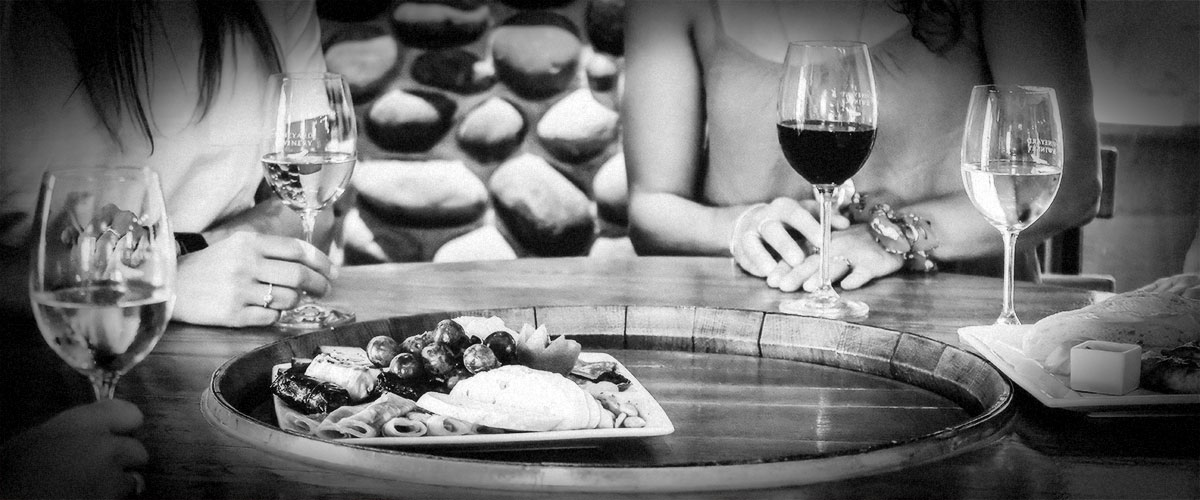by Chris Russell, Contributor
As euphoric an experience as wine tasting usually is, it can be daunting for some, especially the more casual wine appreciators. The good news is you don’t have to be a sommelier to taste wine like a pro. It just takes a little basic knowledge and perspective.
Wine-Tasting Goals
Why do we taste wine? It’s not about finding the “best” and “worst” wines. Instead, it’s all about discovery. Wine exists as a vast landscape. Tasting your way through the landscape is definitely the best, and most enjoyable, way to explore wine, broadening your palate and learning about what you do or do not enjoy. You might think of it as an open-ended journey with no destination. There are no right or wrong answers when it comes to wines you enjoy, and you may end up in a very different wine land from where you started.
Tasting Like a Pro
Fully appreciating the wine you’re currently tasting is as simple as 1-2-3—in other words: 1) see, 2) sniff, and 3) taste. Let’s examine each step a little closer.
1) See
When the wine is poured into the glass, take a few moments to study it. Notice the color. Is it bright red or more brick red or amber-tinged? Is it white with green hints or more golden? Is the wine clear and vibrant, opaque, or even murky? Color often gives away the wine’s age. Swirl the wine gently in the glass and notice how the wine shimmers and may cling to the glass as it settles. “Clinginess” can give hints as to the wine’s body.
2) Sniff
Next, turn your attention to the aroma. Keep swirling the wine gently in the glass, then put your nose in the glass and sniff lightly on your first pass. Inhale more deeply on successive sniffs. As you smell the aroma of the wine, try to pick out the individual components that make up the overall bouquet—not unlike listening to a single voice in a crowded room. Don’t despair if at first all you notice is the aroma of grapes. With time and practice, you may pick up the distinct aromas of berries, citrus, stone fruit, herbs, or even more complex scents like tobacco, cedar, or wet stone, depending on the wine and how it was produced.
3) Taste
It’s finally time to take your first small sip. Taste is largely about the aroma—but with added input from the tongue, which perceives salty, sour, sweet, bitter, and savory, or umami, flavors. Wines are rarely truly salty, but there’s much to enjoy about the subtle interplay between sour and sweet, often referred to as a wine’s “balance,” resulting from the natural acids in the grapes and the residual sugars after fermentation. You may sometimes also perceive bitterness in some wines, both from the natural minerals present in the wine as well as the tannins that can arise from both the grapes themselves and the oak barrels some wines are aged in. Again, perception is individualistic. Not everyone perceives the same amount of acid as tart, sugar as sweet, or tannins as bitter.
While you’re tasting, your palate can also perceive the feel of the wine, or its texture. Wines, especially reds, can feel silky, smooth, rich, or even chewy or coarse. Tannins, alcohol, acid, polysaccharides, and other components all contribute to a wine’s mouthfeel.
Taste doesn’t stop immediately once the wine leaves your mouth, either. This last component, the wine’s “finish,” can range from short and simplistic to long and complex—at times, even more so than the initial taste of the wine itself. The final impression the wine leaves with the taster, the finish can sometimes endure and develop for more than a minute after the wine is gone. The finish is typically what reveals the honest truth about a wine’s balance, concentration, and potential longevity.
Bringing It All Together
Once you’ve finished tasting a wine, it’s ultimately up to you to decide how you feel about it. Did you fully enjoy it, or did it seem like something was missing? Was there an aspect of the wine you especially appreciated or one that wasn’t to your liking? Would you like to try more wines like this one or explore in a different direction? Again, there are no wrong answers here. It’s entirely up to you.
Don’t be afraid to ask questions during your tasting. It’s one of the best ways to learn about the finer details of wines you enjoy or don’t enjoy. You may even want to take notes, especially if you’re going to be tasting many wines. Jotting down what you liked and didn’t like about a particular wine can prove an excellent resource later on, especially when you’re in search of the perfect wine for a specific occasion.
To spit or not to spit? It’s a personal choice and undeservingly something of an embarrassing topic. After all, we generally don’t spit in polite company. Wine tasting is the exception, however! If you’re tasting several wines in close succession, you’ll remain more clear-headed, objective, and discriminating if you limit your consumption. On the other hand, if you’re conducting a shorter tasting session of smaller portions, you may prefer to savor the full experience of swallowing those small amounts of wine with minimal risk of intoxication.
To keep your palate fresh and sharp, avoid tasting too many wines back to back, especially full-bodied reds or high-acid whites. In addition to allowing a little time, small bites of mild food (flavorful food can interfere with tasting the wine) or even sips of water can help you enjoy the next wine—or even another sip of the same—as if it were your first. Remember to refresh your nose, as well. A short stroll around the tasting room grounds can usually clear your nose of wine aromas and as well as freshening up your palate.
What to Taste in Southern Oregon
Wine is often an intensely regional affair, and Southern Oregon is no exception. We’ve already discussed the unique microclimates and soils that make the Rogue Valley a particularly diverse winemaking region. So what should you taste if you’re visiting Oregon wineries? Everything you can! An exploratory flight at a tasting room is a wonderful starting point if you’d like to get an overview. If, on the other hand, you’re trying to zero in on a particular aspect of Southern Oregon wine, you may want to limit your tasting to just reds or whites. In uncertain situations, ask for recommendations. Skilled tasting room staff can be invaluable guides as you navigate your wine-tasting journey.
Learn More
We hope you’ve enjoyed these tips on how to get the most out of a wine tasting, and we look forward to seeing you in our own tasting room soon! If you’d like to continue learning about making and savoring wine, keep up on the latest happenings at 2Hawk, and discover our latest offerings, subscribe to our newsletter and you’ll always have the latest news. Do you have any questions about our wines, our vineyard, or the winemaking process? If so, we’d love to hear from you! Please comment below or reach out to us directly via our Contact page.
Meanwhile, if you’d like to find out more about our Rogue Valley wines, here are a few ways:
- Wondering if wine has a place in your healthy lifestyle? You may enjoy last month’s blog post, What Are the Health Benefits of Drinking Wine?
- Visit the tasting room to sample our current wines.
- Follow us on Facebook and Instagram to keep up with the latest happenings.

